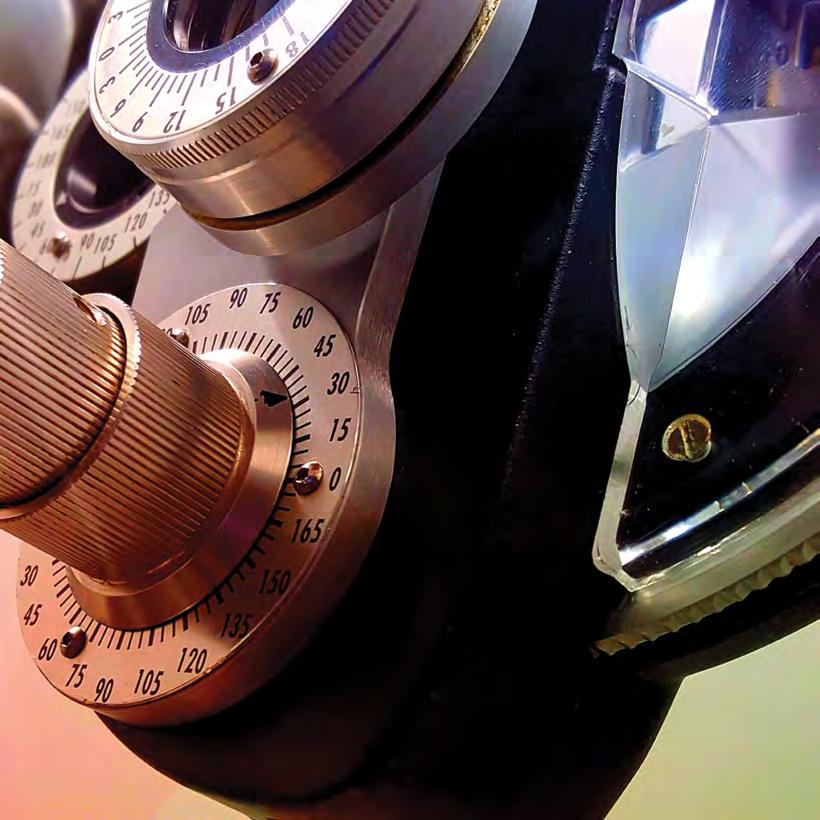
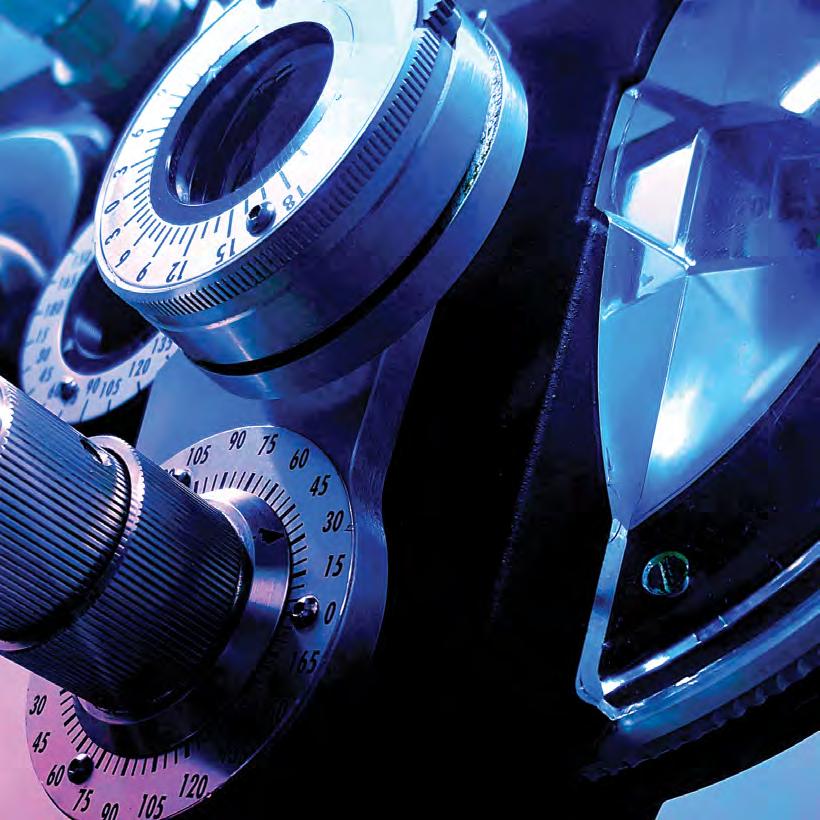
INVEST IN YOUR FUTURE 2023-2024
$204, 773
AVERAGE NET INCOME FOR OPTOMETRISTS WHO OWN ALL OR A PORTION OF THEIR PRACTICE
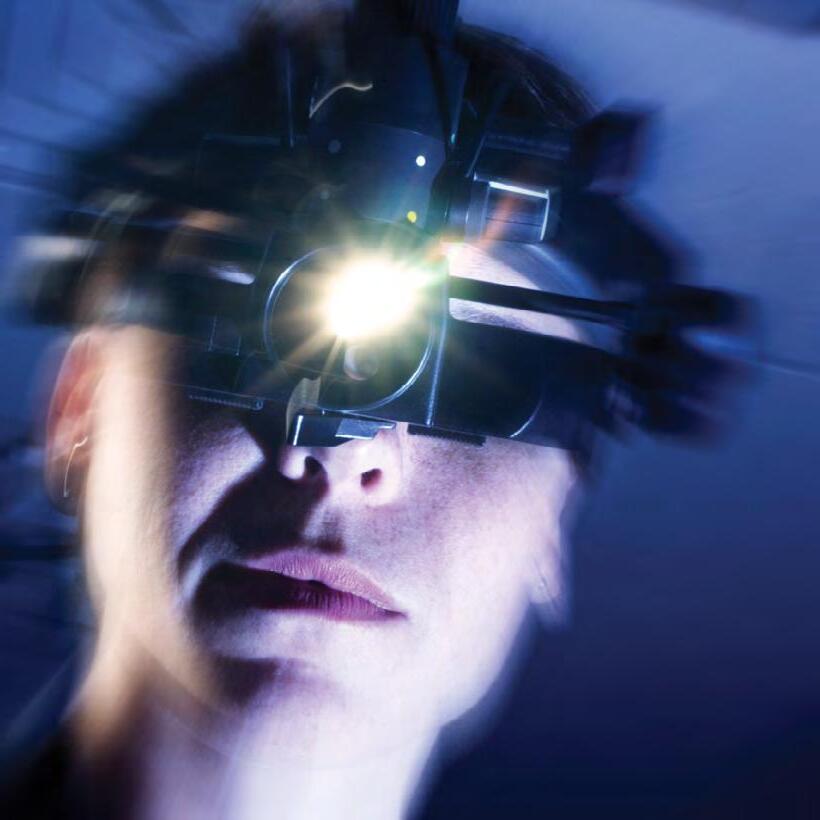
Optometry as a Career
During your educational journey, many windows of opportunity will open for you. Whether through your courses, organizations or simply the people you meet. No matter which avenue you pursue, the key to finding the best career match for you is to keep an open mind. We at Southern College of Optometry (SCO) encourage you to explore your options and ask questions.
WHO ARE OPTOMETRISTS?
Optometrists are primary care providers for eye and vision care who diagnose, treat and manage diseases and disorders of the eye, the visual system and associated structures.
WHERE DO OPTOMETRISTS WORK?
Anywhere and everywhere! Optometrists work in a variety of settings ranging from a solo or group private practice, to larger venues such as hospitals, health maintenance organizations and referral centers.
IS THERE MORE TO OPTOMETRY THAN GLASSES AND EYE EXAMS?
The optometric field is vast, diverse and growing every day. Optometrists are now providing patient services in the areas of specialty contact lenses, low vision rehabilitation, vision therapy, sports vision rehabilitation and post-surgical care, just to name a few.
WHAT IS THE DAY-TO-DAY LIKE FOR AN OPTOMETRIST?
Flexibility allows optometrists to enjoy a work/life balance that prioritizes personal health and family. Many optometrists own or partner a practice and experience the role of not only doctor and healthcare professional, but also small-business owner.
WHAT INCOME CAN AN OPTOMETRIST EXPECT TO EARN?
If you are interested in a profession that helps people live better lives, provides a stimulating work environment, and allows you and your family to enjoy a comfortable lifestyle without sacrificing work/life balance, optometry is a career you should investigate!
Data from the American Optometric Association’s 2022 Survey of Optometric Practice shows the average net incomes ranging from $168,193 for the primary practice of optometry to $204,773 for optometrists who own all or a portion of their practice.
3
SCO 101 5 COMMITTED TO SERVICE 7 STUDENT LIFE 9 CAMPUS DEMOGRAPHICS 11 MEMPHIS 13 ADMISSIONS 15 FINANCE AND MANAGE DEBT 17 SCHOLARSHIPS AND AWARDS 19 FAQS 21 TIMETABLES AND FACTS 27
At SCO, your educational training will prepare you for an outstanding career. Remember, your education is an investment in your future. If you make sound decisions now, you will reap the benefits later.
ESTABLISHED IN 1932
7000+

ALUMNI PRACTICING IN ALL 50 STATES AND WORLDWIDE
532 STUDENTS ATTENDED SCO IN 2022-2023
9:1 STUDENT-TOFACULTY RATIO
SCO 101
Founded in 1932, Southern College of Optometry is an independent non-forprofit coeducational institution of higher learning. As the largest optometry school in the southern United States, SCO has graduated over 8,000 optometrists, including 12 presidents of the American Optometric Association.
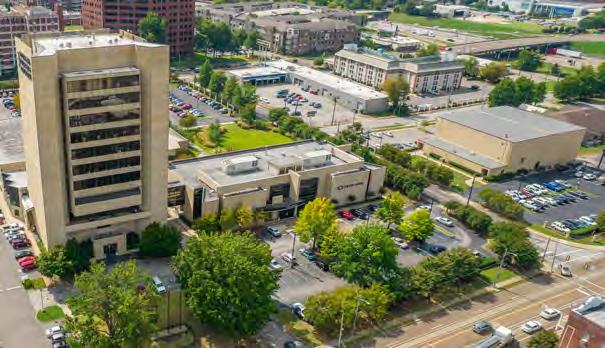
SCO offers a four-year curriculum with courses in the biomedical, optometric and clinical sciences leading to the Doctor of Optometry (O.D.) Degree. SCO’s advanced facilities feature biomedical labs, expanded and renovated optometry labs, laser instruction, and biomedical and clinical research areas.
The college’s academic facilities utilize cutting edge technology and interactive instructional methods. In 2013, SCO built a state-of-the-art academic and educational facility to provide greater classroom space and technology access over 23,016 new square feet of space. SCO also offers a 14,264 square foot Activity Center that features basketball, volleyball and racquetball courts, fitness equipment, aerobics, along with a recreation area.
With a low 9:1 student-to-faculty ratio, SCO’s faculty are easily accessible for one-onone classroom and/or clinical instruction. Faculty members are all practicing optometrists, and many engage in a wide range of research projects, including a collaborative summer research program with students. By contributing to basic and visual science literature, faculty research enriches each student’s classroom experience.
Our mission
lifelong
5
learning, to service.
SCO AWARDED VOLUNTEER MEMPHIS’ 2019 CORPORATE CITIZEN OF THE YEAR
MEDIUM EMPLOYER CATEGORY
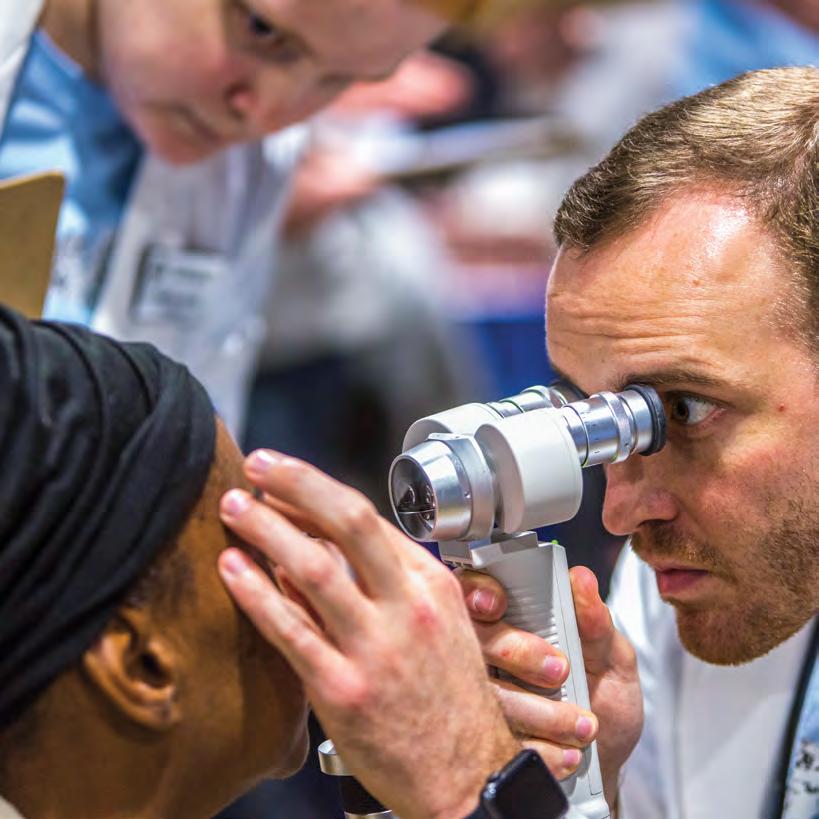
Committed to Service
One of the hallmarks of the SCO mission is fostering a personal commitment to service. Optometry is a profession dedicated to enriching not only the visual health, but also the everyday lives of patients. That same sense of helping others is encouraged in SCO’s students through service-learning.
SCO’s students serve others in a variety of positive ways. Some are active in the local community by tutoring and mentoring at risk students. Others volunteer their time with service projects such as the annual Dr. Martin Luther King Jr. Day of Service event where volunteers paint or renovate a local school.
Student Volunteer Optometric Services to Humanity (SVOSH) is one of SCO’s most popular student organizations; it provides free eye care and glasses to impoverished international areas via annual 10-day service trips. Since 1975, members of SVOSH have served over 200,000 patients in 16 different countries.
Students also participate in Remote Area Medical to provide vision screenings in underserved areas. Volunteering at the Special Olympics is another way our students give back during their time at SCO.
Whether volunteering time or service through an awareness event or a student organization, opportunities are plentiful for the SCO community to make a difference in the lives of others.
SCO’s clinical education is also designed to highlight the people-focused aspects of optometry and ensure students have the experience needed
to be exceptional doctors. Our clinical facility, The Eye Center, is one of the largest state-of-the-art vision and eye care facilities in the nation and the center of our patient care.
The Eye Center has 48,000 square feet of usable space and provides the opportunity to introduce clinical exposure to the students early in the curriculum.
It is designed to be patient, student and doctor friendly, while also incorporating the most up-todate features and equipment such as:
• Examination rooms equipped with the latest in electronic health record management systems.
• 14 individual spaces for advanced technology-based testing.
• A retinal laser center.
• A digital angiography center.
• An advanced procedures and observatory suite.
• Conference rooms for group learning.
• A patient simulation laboratory.
• An optical service area.
• Practice suites which enable interns to experience an exceptional practice atmosphere with the attending staff doctors.
In addition to The Eye Center, students also join faculty members and interns in seeing patients at FocalPoint at Crosstown Concourse and University Eyecare on the campus of the University of Memphis. The MobilEYES Community Vision Unit takes care directly to patients as it travels throughout the community.
7
Optometry is a people profession dedicated to enriching the vision health and lives of patients.
STUDENTS, FACULTY AND STAFF RAN THE 2022 ST. JUDE MARATHON

103
Student Life
Approximately 90% of SCO students are active members in at least one student organization. For almost any organization which exists on undergraduate campuses, a comparable organization is active at SCO.
The Student Government Association (SGA) recommends policies and coordinates many of the academic, service and social events on campus. The SGA also oversees an extensive intramural program open to all students, spouses, faculty and staff. Intramural sports include basketball, softball, golf, flag football, racquetball and volleyball, with many events housed in the SCO Activity Center.
STUDENT ORGANIZATIONS
American Optometric Student Association (AOSA)
A national organization of optometry students dedicated to the enhancement of educational, political and professional concerns.
Amigos
Dedicated to providing a venue for students seeking to enhance their Spanish conversation skills..
Beta Sigma Kappa
An international optometry honor fraternity whose purpose is to stimulate scientific attainment and ethical practice.
College of Optometrists in Vision Development (COVD)
Dedicated to raising awareness that vision involves more than eyesight and to expanding the number of students that will deliver developmental vision care and vision therapy to their patients.
Contact Lens Society
Open to third- and fourth-year students interested in expanding their knowledge of contact lenses through presentations by guest lecturers.
Fellowship of Christian Optometrists
For the promotion of good will and Christian belief within the profession of optometry.
Gamma Omicron
Dedicated to increasing awareness of women’s issues in optometry, networking opportunities and professional development.
Gold Key Society
Honors outstanding students whose professional and ethical attitudes are in the interest of service to their class, college and profession.
Lions Club
Promoting service through community involvement, especially working with those who are visually impaired.
Low Vision Club
Providing information for students interested in low vision patient care.
National Optometric Student Association (NOSA)
Dedicated to increasing minority representation in optometry.
Neuro-Optometric Rehabilitation Association (NORA)
Focused on bringing an interprofessional approach with multiple health care providers in order to advance the art and science of rehabilitation for brain injury patients.
Omega Delta, Iota Chapter
Oldest and largest optometric fraternity; activities include the SCO holiday party, tutoring retinoscopy for first-year students, camping and canoe trips, and other social events.
Ocular Disease Club
Dedicated to increasing exposure to ocular disease by discussing rare cases and learning more about future aspects of a career in disease management.
Optometric Private Practice Club
Dedicated to preparing students for the business of optometry by providing resources and information from experienced persons, practices and business entities.
Spectrum
A school community where all students and faculty/staff feel welcome and supported, regardless of sexual orientation or gender identity.
Sports Vision Society
Provides vision care to athletes at the state and international levels.
State Clubs
A collection of students interested in practicing in a particular state.
Student Ambassador Program
Members assist in student recruitment, admissions and public relations functions for the college. Ambassadors are selected each year from the first-year class on the basis of academic performance, nominations by faculty and staff, and interviews.
Student Chapter of the Academy of American Optometry (SCAAO)
Official student chapter of the academy, promoting research and scholarly activity in optometry.
Student Public Health Vision Care Association (SPHViCA)
Connecting students who have an interest in public health to promote health and wellbeing, with an emphasis on vision and eye health.
Student Volunteers in Optometric Service to Humanity (SVOSH)
SVOSH members work year-round to prepare for their annual 10-day service trips. Activities include collecting, inspecting and sorting donated eyeglasses, and various projects to help finance travel expenses. Membership is open to all interested students.
9

Our student diversity makes the SCO experience a true learning endeavor.
ENTERING CLASS OF 2022: 133 UNIQUE INDIVIDUALS 89
44
Campus Demographics
SCO is one of the most regionally diverse optometry schools in the nation. Our student body represents various academic backgrounds, ethnicities and life experiences. For example, our 2022-2023 student body came from 45 states, China and Canada. Our diversity makes the SCO experience a true learning endeavor. The geographic representation of the SCO student body for the 2022-2023 academic year was as follows:
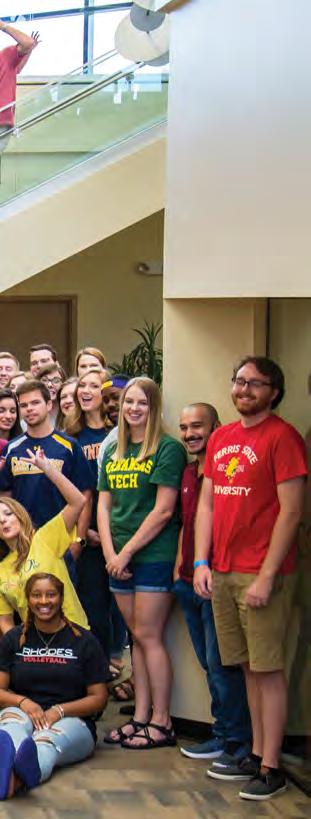
20-34 AGE
23 MEAN AGE 20 MARRIED
113 SINGLE
11
Alabama 6 Alaska 1 Arizona 3 Arkansas 22 California 7 Colorado 3 Connecticut 2 Delaware 0 Florida 34 Georgia 24 Hawaii 1 Idaho 5 Illinois 18 Indiana 7 Iowa 15 Kansas 21 Kentucky 24 Louisiana 26 Maine 0 Maryland 10 Massachusetts 1 Michigan 13 Minnesota 13 Mississippi 33 Missouri 16 Montana 1 Nebraska 16 Nevada 2 New Hampshire 1 New Jersey 1 New Mexico 2 New York 0 North Carolina 29 North Dakota 0 Ohio 16 Oklahoma 3 Oregon 2 Pennsylvania 8 Rhode Island 2 South Carolina 8 South Dakota 2 Tennessee 60 Texas 22 Utah 8 Vermont 0 Virginia 13 Washington 6 West Virginia 6 Wisconsin 11 Wyoming 1 Canada 6 China 1
FEMALE
MALE
RANGE
SCO SERVES AS THE OFFICIAL EYE DOCTORS OF THE MEMPHIS REDBIRDS AND THE 901FC SOCCER FRANCHISE
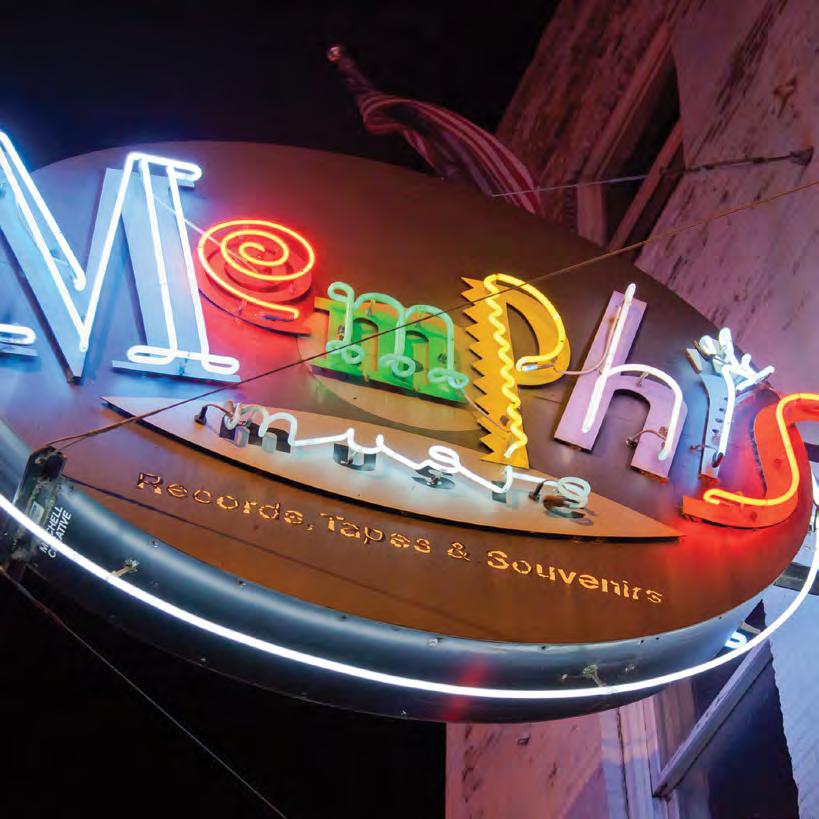
Memphis, TN: The Bluff City
Memphis, TN is SCO’s hometown and the secret behind why our student experience is so enjoyable. A big city with a small-town feel, Memphis has one of the lowest costs of living in the nation. This allows our students to enjoy many of the things a major metropolis has to offer, yet at an affordable price.
MUSIC
Sitting on the banks of the mighty Mississippi River, Memphis is known for its rich musical heritage. SCO students have many opportunities to enjoy the sounds of Memphis and visit historical and cultural hubs such as:
• Graceland, the home of Elvis.
• Beale Street, birthplace of rock ‘n roll.
• Numerous musical clubs ranging from blues to gospel.
• An array of music festivals throughout the year.
CULTURE
Memphis is world-renowned for its culture. The Memphis in May International Festival, the city’s premier cultural experience, annually hosts and celebrates another country’s culture, music and cuisine. This festival also sponsors the World Championship Barbecue Cooking Contest, and the Beale Street Music Festival. Memphis features several unique and award-winning museums, such as the acclaimed National Civil Rights Museum. Memphis also hosts a diverse range of touring musicians, performers and Broadway productions at the historic Orpheum Theatre, in addition to our very own Ballet Memphis, Opera Memphis, the Collage Dance Collective and the Memphis Symphony Orchestra. The city is also home to a great selection of locallyowned restaurants with a broad range of cuisines, most of which are well within a student’s budget.
Conveniently, many of these attractions are located in or near the city’s rejuvenated Downtown area, just minutes from SCO.
FAMILY FRIENDLY
Students with families find Memphis a great place to live. Because the city offers such a low cost of living in a reasonable
housing market, about 10% of SCO students are able to own a home. The city is also home to the wonderful Children’s Museum and the Memphis Zoo and Aquarium, both of which offer family discounts.
Memphis features several immersive shopping venues, including one of the largest retail stores in the world, Bass Pro Shops at the Pyramid. The massive destination experience offers something for everyone, from serious outdoor enthusiasts to fun-loving families.
SPORTS
The Memphis sports scene is very active. The city is home to several professional teams and tournaments, such as:
• The Memphis Grizzlies (NBA)
• The Memphis Redbirds (AAA Baseball)
• The 901FC Soccer Team (USL Championship)

• The FedEx St. Jude Invitational (WGC)
If you prefer college sports, the city not only has the University of Memphis, but it is also in the heart of the Southeastern Conference.
Many of these major sporting events are held at either the FedEx Forum or AutoZone Park –voted one of the best baseball venues in America – both centrally located in Downtown Memphis.
Due to the moderate weather we have in Memphis, our students enjoy all of the music, culture, sports and outdoor activities this city has to offer year-round.
13
3.69 |
 335
AVERAGE GPA | OAT SCORES FOR THE ENTERING CLASS OF 2022
335
AVERAGE GPA | OAT SCORES FOR THE ENTERING CLASS OF 2022
Admissions
SCO participates in the centralized application service known as OptomCAS. The service collects student information, official transcripts, Optometry Admission Test (OAT) scores and letters of recommendation, then forwards them directly to optometry schools. SCO accepts applications June 30 through March 1 of each year; however, applying in the early stages of the cycle is strongly encouraged. SCO utilizes a rolling admissions process and offers of acceptance begin in August.
or university. Strong preference is given to applicants with baccalaureate or higher degrees. The required pre-requisite courses are as follows:
• General Biology
w/Labs (1 year)
• Microbiology w/Lab (1 course)
• General Chemistry
w/Labs (1 year)
• Organic Chemistry
w/Lab (1 course)
• Biochemistry (1 course)
• General Physics
w/Labs (1 year)
• Calculus (1 course)
• Statistics (1 course)
• General Psychology (1 course)
• Social Science (1 year)
• English (1 year)
SCO requires a minimum of two letters of recommendation: one from a pre-health advisor or natural science professor, and one from a non-relative optometrist with whom the applicant has worked or shadowed. OptomCAS accepts up to four letters of recommendation, but be sure these two are among those submitted.
Before an interview invitation can be extended, SCO must receive all application and supplemental documents, as well as the official OAT scores. Interview invitations are only extended to the most promising applicants based on academic performance, OAT scores and experience in optometry.
A minimum of 90 semester (or 135 quarter) hours of undergraduate work is required for admission, with at least 30 semester (or 45 quarter) hours completed at a four-year college
For the 2023-2024 academic year, non-regional tuition is $41,536. A limited number of regional seats are available for competitive applicants from states that support contracts with SCO. The contracts provide eligible students with significant reduction in tuition. For more information on regional seats, please contact the Admissions Office or visit sco.edu/state-residency-certification.
SCO attracts students nationally and internationally, and it recruits directly from close to 100 campuses every year. Updated listings of campus visits or presentations are found in the Events for Prospective Students section of the SCO website.
Prior to application, prospective students are encouraged to schedule a campus visit to meet with an admissions officer and receive a tour of SCO. For more detailed information or to schedule a campus tour, contact the Student Services Office at admissions@sco.edu or call (800)-238-0180. More information can also be found on our website at sco.edu.
15
Like any endeavor worth pursuing in life, it takes careful preparation to become an optometrist.
24
# OF YEARS OUR GRADUATES HAVE MAINTAINED A 0% DEFAULT RATE ACCORDING TO THE DEPARTMENT OF EDUCATION

Finance and Manage Debt
One of SCO’s primary objectives is to provide students with the means to complete our program with the least possible debt at graduation. The first step in managing debt is controlling what you spend.
Our Financial Aid Office works individually with students to develop realistic financing strategies. Counselors meet with students at least annually through our Debt Management Program to make sure students have sufficient funds at the best rates, and that they are borrowing wisely. Our Debt Management Program educates students on how debt can also be minimized through budgeting, personal savings, maintaining zero credit card balances and part-time work. This program, coupled with minimal tuition increases and added scholarships and awards, has led to SCO graduates having a 0% default for 24 out of the past 25 years.
Below is a loan repayment chart for an SCO graduate who accumulates $150,000 in student loans. The chart uses annual net income projections in line with national averages and is assuming a repayment period of 10 years with no deductions taken.
This chart uses a federal loan rate of 6.54%. Since some graduates have tax deductions (i.e. marriage, children, mortgage, etc.), these estimates are conservative. Many SCO graduates choose to slightly increase the amount of their monthly repayments. This method, even with only a small increase each month, will shorten a 10-year repayment schedule by several years.
FEDERAL WORK-STUDY
SCO participates in the Federal Work-Study Program, which allows students to work on campus up to 20 hours per week towards their educational expenses.
To apply for Federal Work-Study, each student must submit the Free Application for Federal Student Aid (FAFSA) to the Federal Government. A student’s ability to contribute to educational costs will be calculated according to Federal criteria and will determine eligibility.
Graduating with the least possible debt allows our alumni greater flexibility in repaying loans and thus greater personal financial freedom. SCO’s Office of Financial Aid offers a debt management program where financial aid officers work closely with each student in developing a budget and planning out financial needs, leading our students to be better borrowers.
17
Years After Graduation Annual Net Income After Tax Net Monthly Income Monthly Loan Repayment After Tax Net Monthly Income After Payment 1 $130,000 $8,319 $1,706 $6,613 2 $140,000 $8,889 $1,706 $7,183 3 $150,000 $9,458 $1,706 $7,752 4 $160,000 $10,028 $1,706 $8,322 5 $170,000 $10,384 $1,706 $8,678 6-10 $180,000 $10,951 $1,706 $9,245
$850,000 APPROXIMATE DOLLAR VALUE OF SCHOLARSHIPS AWARDED TO THE ENTERING CLASS OF 2023

Scholarships and Awards
SCO offers a significant number of endowed scholarships and awards for incoming students. Eligibility requirements vary, but most require exemplary achievements in academics, OAT performance, leadership and/or service. SCO annually awards four-year scholarships to more than one-half of each entering class.
Approximately $850,000 were awarded to the entering class of 2023 through the endowed scholarship fund. A complete listing of scholarships with the requirements for each is published in the college catalog.
Annual scholarship approximations for the entering class of 2023 include:
• $25,000 (3)
• $20,000 (15)
• $15,000 (10)
• $10,000 (20)
• $7,000 (10)
• $5,000 (30)
• $1,000-3,000 (30)
In addition to the endowed scholarships for entering students, SCO offers other endowed scholarships and awards to currently enrolled students through the Annual Student Awards Program. Overall, approximately 60% of SCO students receive academic scholarships ranging from $1,000 to $25,000 per year, and we are actively seeking ways to expand scholarship opportunities.
Rewarding academic and clinical achievement through scholarships is a top priority for the college and its alumni.
In addition to scholarship offered by SCO, select students are awarded federal scholarships through the miltary and Indian Health Services. Also, AR, KY, NC and VA offer state scholarships (selected by the state) which several SCO students receive.
19
Rewarding academic and clinical excellence through scholarships is a top priority for the college.
FAQs

How do I apply for admission, and how difficult is it to get into SCO?
Morgan Hooker | Amarillo, TX | SCO Class of 2026
The application process for optometry school can seem overwhelming; however, getting started early allows you plenty of time to move at your own pace. The first step is to create an OptomCAS account. There are four sections to the OptomCAS application that include personal information, academic history, supporting information and program materials. The Optometry Admissions Test (OAT) is required for most applications and should be taken before or during the application process. Taking the OAT as early as possible allows you time to retake if you need to try for a higher score.
Once the application is completed and sent to your selected schools, you will receive an invitation for an admissions interview. The in-person interview process at SCO includes: a one-on-one meeting with a faculty member, a counseling session with our admissions department, a Memphis bus tour, a financial aid and housing information luncheon, a campus tour, a class sit-in, and a reception to wrap up the day. SCO wants to show each interviewee the full scope of what it means to be a member of our community.
SCO prides itself on academic excellence and hard work, and it shows with incoming class statistics. This past admissions cycle, the Class of 2026 had 771 applicants and 133 matriculants. The average undergraduate GPA was 3.69 with an average OAT score of 335. Don’t let these number intimidate you; the SCO admissions team considers many other factors when accepting applicants!
The biggest piece of advice I can give is to, again, start and submit your application as early as possible. Do not be afraid to reach out to the SCO admissions team
if you have any questions. They are more than willing to help. Also, be yourself on your application and during your interview. The whole process can be intimidating, but SCO is very student-friendly and assists you along the way.
What are the similarities and differences between optometry and medical school?

 Donnie Koonce | Charlotte, NC | SCO Class of 2024
Donnie Koonce | Charlotte, NC | SCO Class of 2024
Medical school and optometry school are similar in a lot of ways.
First, they both require prospective students to complete prerequisites in math and science courses (contact your desired optometry school to determine what you need to take).
Secondly, both schools require applicants to take an admissions test. Optometry schools often require the Optometry Admission Test (OAT), and medical schools often require the Medical College Admission Test (MCAT). Both of these tests ensure mastery of basic knowledge in Biology, Chemistry, Organic Chemistry and Reading Comprehension; however, the OAT includes a Physics section, whereas the MCAT includes a Behavioral Sciences section. Both schools will have multiple applications and an interview round.
The overall structure is similar between medical school and optometry school once you are accepted into your respective programs.
Your first two years are comprised of didactic courses. Both schools will require higher level science courses such as Anatomy, Neuroanatomy, Biochemistry and Pharmacology; however, they differ in the material of some classes. Keep in mind that medical school requires students to learn about all parts and systems of the body in order to prepare them for any medical field. Optometry school places more of an emphasis on the ocular system
21
and has several classes that might not be covered in the first two years of medical school.
The third and fourth years of both schools introduce students to the clinic. The third year is a mixture of clinical experience and a lighter course load. The fourth year is almost exclusively externships and rotations to ensure students get maximum exposure in patient care. The students will see their own patients under a staff doctor.
Throughout your time at both schools, you will be tested with national board exams. Board exams are taken in three parts, and both future ODs and MDs are required to pass all three before they can obtain their licensure and practice.
After you finish your four years of optometry school and pass your boards, you are free to begin practicing optometry. This differs from medical school in the sense that you are required to do a residency to specialize in a field of medicine before you’re able to practice.
A residency is further advancement in education in a concentrated area such as pediatrics or primary care. Medical residencies range anywhere from three to seven years, adding additional time to a future MDs medical training. Optometrists have the ability to do a one-totwo-year residency, and they’re becoming steadily more popular; however, a residency is not a requirement.
Even though medical school is a prestigious and worthwhile path to take, if you have a passion for vision and ocular health, optometry is the field for you!
How expensive is optometry school?
How will I finance my education?
Noah Linhart | Derby, KS | SCO Class of 2025 Optometry School, like any other Doctoral/Medical Program, comes with a high price tag. Between the tuition, fees, equipment, books, housing and cost of
living, it is unlikely that many students will graduate without some form of student debt. However, by choosing to attend SCO, I have improved my financial security during and after optometry school.

SCO has a very robust program and runs one of the largest eye care centers in North America. As such, this allows them to offer tuition to students at one of the lowest prices of any school in the country, along with a world class education. SCO also makes a lot of scholarship money available to students, and a total of 90% of current students were awarded some form of financial aid. The cost of living in the Memphis area is also very competitive. It Is fully possible to find great, safe living accommodations for a fraction of the price that you might find in another major city.
The financial aid department also helps students put together a stellar financial aid package that considers scholarships, awards and student loans, as well as any specific financial budget. They make the process easy, intuitive and flexible should you need to adjust your award for any reason.
All of this together makes SCO one of the most budget friendly optometry schools available. I personally found that I could graduate from SCO with half of the student debt that I might expect at my second-choice school. However, even with all of these savings, you still need to careful with your money.
One of my best pieces of advice would be to create a budget! Consider your rent, groceries, gas etc. Make sure to factor in the expenses that you might not originally think about as well, such as fees for clubs you may want to join, or technology. Always make sure to budget in a little bit of money for fun as well. Optometry school will be challenging, so you want to make sure you give yourself a little grace in your budget for non-school related activities to help keep spirits high.
Optometry school will not be cheap, but hopefully your choice to come to SCO will help lessen your financial burden significantly. The amount of knowledge and skills you are going to obtain will be well worth the costs. Always remember, the money you spend while in optometry school is an investment in your future.
Do I need a degree in science?
Saniya Merchant | Wheeling, IL | Class of 2025

I came into SCO having completed my degree in psychology and a minor in Spanish at the University of Illinois at Urbana Champaign. That being said, you certainly do not need to have a degree in science to apply to optometry school. In our entering class, we have students from all kinds of undergraduate backgrounds, and that helps to diversify our program even more. There are specific courses that must be taken before applying to optometry school, and these can be taken in addition to your major. As these can vary by school, it is best to stay on track with the required classes with the help of an academic advisor. While this does increase the workload a bit, I would say having the ability to major in something I was personally interested in far outweighed the cost.
Students may think they will be at a disadvantage not coming in with a science background, but I would reassure these students that SCO does a great job at laying the foundation during your first-year classes and ensures everyone has the same level of understanding. As you are not limited to any specific degree that is required for a future in optometry, I would advise prospective students to pursue a major they are passionate about, whether that be in science or in another field.
Is optometry a career with a strong future? How will I find employment after graduation?

 Noah Scoffield | Peoria (Phoenix), AZ | SCO Class of 2026
Noah Scoffield | Peoria (Phoenix), AZ | SCO Class of 2026
Optometry has an incredibly strong future due to its expanding scope of practice. As a legislative profession, optometry’s scope is dependent on the various laws of a particular state, but each year, more and more states are allowing optometrists to practice different specialties and new procedures. Due to this changing landscape, not only will there be more procedures to perform in the future, but there will be more patients for practicing optometrists to see, as well. All of this contributes to the increasingly bright future for optometrists.
There are many resources available to students to prepare them for employment. The Hayes Center for Practicing Excellence provides everything you’ll need, including networking events, interview practice and even contract review. The Center also compiles a list of all the open positions across the country, so that when the time comes, students will be able to take advantage of the opportunities available to them. With the Center’s help, students can feel at ease as they navigate their future after graduation and find the ideal start of their professional career.
How will The Eye Center enhance my education at SCO?
Weronika Przepiora | Sarasota, FL | SCO Class of 2024
Southern College of Optometry provides students with an exceptional didactic optometric education, but The Eye Center (TEC) is where SCO really shines.
Every day, TEC provides eyecare to over 350 patients coming from various backgrounds and socioeconomic statuses, which contributes to a majority of the 2,6002,900 patient encounters students will have before
23
graduation. Many of our patients have ocular diseases and systemic conditions that we learn to treat early on. The 4:1 student to staff doctor ratio allows us to make clinical decisions ourselves, while also talking through each case, interpreting testing results and planning treatment ourselves, with the guidance of an experienced physician.
Along with general comprehensive eyecare, the specializations within TEC allow us to experience optometry to the fullest scope. From Pediatrics to Low Vision, Vision Therapy to Ocular Disease, students can gauge their interest and work with residency trained physicians in those specialties. To keep up with the expanding scope of practice, our new Optometric Surgical Services suite allows students to perform surgical procedures with ophthalmic lasers on live patients.
As a third-year student, I can honestly say that I’ve grown immensely in my clinical capabilities and knowledge of ocular conditions. I know our experience at TEC has equipped us well as we prepare for fourthyear externship rotations and ultimately our optometric careers.

How difficult is optometry school?
Will I have time for my family/ personal life?
Rafael Martinez | Sanger, CA | SCO Class of 2026
Optometry school can be like drinking water through a fire hose — this is no overstatement. The material being taught is similar to what is taught in undergrad, but the sheer volume of material differs immensely.
The key to success in optometry school is to learn how to manage your time, especially for a student with a family like myself. It is easy to get distracted. Being organized with a planner or a to-do list are simple ways to stay on track throughout each day. Falling behind is something that can happen quickly, so it is best to stay on top of
your classes and your coursework. There are many resources available to students to help you succeed: tutors, recorded lectures and open labs, to name a few.
Something that I love about SCO is that all of the faculty are optometrists, and they are able to take the material they teach and relate it back to the relevance of the eye. This is great because it keeps you engaged. Another aspect that helps with the difficulty of optometry school is that all of your peers are working towards the same goal. Having classmates going through the same experience allows you to feel better supported.
Lastly, I feel it is important to set expectations for yourself and your friends and family. Explaining to your loved ones how busy you are, and how time-consuming school can be, will help them be more understanding. Some weeks, you will feel like you don’t have time for anything but school. Then, there will be stretches where you have plenty of free time.
Success does not come without sacrifice; my wife and two kids know this well, which is why when we do have free time, we make the most of it. Usually, our time together consists of going to the zoo, exploring Memphis and the surrounding areas, playing at Shelby Farms, and trying new restaurants!
Is it difficult to work while going to optometry school?
Jerbrea Powell | Byram, MS | SCO Class of 2026

That definitely depends on how busy you like to be!
Optometry school is comparable to working a full-time job with 40–80-hour work weeks. A typical day for me consists of going to the gym, attending three to four morning classes, attending one to two afternoon labs, practicing lab skills, and studying for courses in the evening. A schedule like this doesn’t allow much time for an additional job.
Fortunately, there are opportunities like federal work-study that are available to certain students who qualify. There are several work-study jobs on campus that are flexible and can be tailored specifically to a student’s schedule. Work-study positions include helping in different departments (i.e., Library, Institutional Advancement, Mail Center), tutoring first- and secondyear students, or being a teacher’s assistant. Another perk of work-study is that you can use any free time on the job to study.
Currently, I have a work-study position in the Financial Aid department. Since it’s on campus, I don’t have to drive out of my way, and I can pick up an hour or two between labs and classes. These 6-8 hours a week add up, and I believe the pay is comparable to retail part-time jobs. This extra spending money really helps me have more room in my budget
What activities are available to students at SCO?
Helen Zhong | Artlington, TN | SCO Class of 2026

When SCO students are not in lecture, clinic or studying, you can find them dispersed throughout the school in their various student organizations. Joining an extracurricular activity gives students the opportunity to learn more about the optometric profession, make connections with their professors and classmates, and even make an impact during their time at SCO!
SCO has multiple honorary organizations that have a focus on leadership and school involvement such as SGA, the American Optometric Student Association (AOSA), the Student Ambassador program, Beta Sigma Kappa, Gold Key Society, and the Student Chapter of the American Academy of Optometry. These organizations provide students with a voice within the profession of optometry and SCO.
To help you select a specialty, SCO has many interest groups such as the Contact Lens Society, Low Vision Club, Ocular Disease Club, Sports Vision Society, NeuroOptometric Rehabilitation Association, and College of Optometrists in Vision Development (COVD). During these meetings, students will get exposure to real patient cases given by guest lecturers as well as networking opportunities. These meetings are a great way to apply topics you have learned in lecture to real case patient scenarios.
Perhaps you may want to join an extracurricular that focuses on volunteering and giving back to your community. SCO offers Student Volunteers in Optometric Service to Humanity (SVOSH), Fellowship of Christian Optometrists, RAM, and Lion’s Club. These organizations provide opportunities for students to treat underserved populations throughout the community and the world.
A great way to destress from school and meet new people is by joining an intramural sport. You are allowed to create your own teams or participate in already established teams such as basketball, dodgeball, volleyball, and more. If you are into fitness, SCO also offers a variety of classes such as yoga and Pilates that meet every week.
SCO knows optometry school can be stressful at times, but they also know students need a balance of both social and academic activities. There are many social events held throughout the year for students to have fun! Omega Delta is our oldest and largest optometric fraternity that oversees events for students. Activities include our very own optometry school formal dance called the Eyeball, camping trips, Halloween parties on Beale Street, and jersey parties.
There are these choices and more to choose from when you’re deciding whether or not to join a student organization. No matter what, students do not just come out of SCO as great optometrists but also as wellrounded individuals!
25

sco.edu SCOnews southerncollegeofoptometry southerncollegeofoptometry SCO edu
Timetables, Facts and Figures
FINANCIAL AID
Registration/Financial
†
Percent
Debt
† Financial aid application packets (SCO application and FAFSA) are sent in early January to students accepted between August and December. For students accepted after January, those financial aid application packets will be sent with their acceptance letters. Enrolled students must reapply annually for financial aid.
ANNUAL SECURITY REPORT
Applicants to Southern College of Optometry may access the Annual Security Report posted on the college website: sco.edu/ campus-safety. The report contains safety efforts and statistics for the campus. Applicants may also request a printed copy by contacting the Safety and Security Department at (901) 722-3312 or by emailing donhenson@sco.edu.
* Regional tuition is available for a limited number of students from each regional state. Acceptance does not guarantee the regional tuition.
** These figures reflect the 2022-2023 year. Updates for the 2023-2024 year can be found on our website (sco.edu).
27
Entering Class Each Fall (Late August) Application Cycle June 29-March 1 Admissions Decisions Rolling First Admissions Decisions Mid-August OAT Administration Deadline March 1 of Entering Year Tentative Class Size 136 States Represented (2022-2023) 45 Foreign Countries Represented (2022-2023) Canada and China Non-Regional Tuition 2023-2024 $41,536 Regional Tuition 2023-2024* Arkansas, Georgia, Louisiana, Mississippi and South Carolina $21,736 Kansas $35,036 Tennessee $28,718** West Virginia $30,036
ADMISSIONS
Financial Aid Application Cycle January-April (All 4 Years)
Aid Disbursements
Semester
Each
Receiving Financial Aid
90%
Management Counseling Annually

1245 Madison Avenue • Memphis, Tennessee 38104-2222 • 901-722-3224 • 800-238-0180 • sco.edu Information for this publication was gathered from the Association of Schools and Colleges of Optometry, the American Optometric Association (AOA), the Journal of the AOA, the Academy of Ophthalmology and the Opticians Association of America.












 335
AVERAGE GPA | OAT SCORES FOR THE ENTERING CLASS OF 2022
335
AVERAGE GPA | OAT SCORES FOR THE ENTERING CLASS OF 2022




 Donnie Koonce | Charlotte, NC | SCO Class of 2024
Donnie Koonce | Charlotte, NC | SCO Class of 2024



 Noah Scoffield | Peoria (Phoenix), AZ | SCO Class of 2026
Noah Scoffield | Peoria (Phoenix), AZ | SCO Class of 2026





